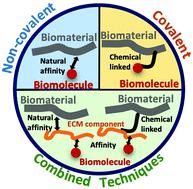当前位置:
X-MOL 学术
›
Mater. Horiz.
›
论文详情
Our official English website, www.x-mol.net, welcomes your feedback! (Note: you will need to create a separate account there.)
Surface biofunctionalization to improve the efficacy of biomaterial substrates to be used in regenerative medicine
Materials Horizons ( IF 13.3 ) Pub Date : 2020-05-26 , DOI: 10.1039/d0mh00542h Marta R. Casanova 1, 2, 3, 4, 5 , Rui L. Reis 1, 2, 3, 4, 5 , Albino Martins 1, 2, 3, 4, 5 , Nuno M. Neves 1, 2, 3, 4, 5
Materials Horizons ( IF 13.3 ) Pub Date : 2020-05-26 , DOI: 10.1039/d0mh00542h Marta R. Casanova 1, 2, 3, 4, 5 , Rui L. Reis 1, 2, 3, 4, 5 , Albino Martins 1, 2, 3, 4, 5 , Nuno M. Neves 1, 2, 3, 4, 5
Affiliation

|
Surface biofunctionalization has emerged in the past decade as a rising tool in Tissue Engineering and Regenerative Medicine (TERM) approaches. The development of biomaterial substrates with regenerative properties is challenging, mainly due to the requirement of obtaining a surface that promotes cell attachment, proliferation and differentiation. Biomolecules, namely extracellular matrix proteins and growth factors, play a key role in the wound healing cascade, mediating a wide range of cellular activities. Therefore, the immobilization of such biomolecules at the surface of biomaterials has a remarkable interest for TERM strategies. Numerous variants can be used to biofunctionalize the surface of biomaterials, being classified as non-covalent and covalent immobilization strategies. Importantly, the maintenance of stable/available bioactive factors needs also to be considered. In this review, a wide range of bioactive molecules and different biofunctionalization strategies will be discussed, as well as the most relevant results achieved in the novel and most promising strategies.
中文翻译:

表面生物功能化,以提高用于再生医学的生物材料基质的功效
在过去的十年中,表面生物功能化已成为组织工程和再生医学(TERM)方法中一种新兴的工具。具有再生特性的生物材料基质的开发具有挑战性,这主要是由于需要获得能够促进细胞附着,增殖和分化的表面。生物分子,即细胞外基质蛋白和生长因子,在伤口愈合级联中起关键作用,介导广泛的细胞活性。因此,将这种生物分子固定在生物材料的表面上对TERM策略具有极大的兴趣。多种变体可用于生物功能化生物材料的表面,分为非共价固定和共价固定策略。重要的,还需要考虑维持稳定/可用的生物活性因子。在这篇综述中,将讨论广泛的生物活性分子和不同的生物功能化策略,以及在新颖和最有希望的策略中获得的最相关的结果。
更新日期:2020-05-26
中文翻译:

表面生物功能化,以提高用于再生医学的生物材料基质的功效
在过去的十年中,表面生物功能化已成为组织工程和再生医学(TERM)方法中一种新兴的工具。具有再生特性的生物材料基质的开发具有挑战性,这主要是由于需要获得能够促进细胞附着,增殖和分化的表面。生物分子,即细胞外基质蛋白和生长因子,在伤口愈合级联中起关键作用,介导广泛的细胞活性。因此,将这种生物分子固定在生物材料的表面上对TERM策略具有极大的兴趣。多种变体可用于生物功能化生物材料的表面,分为非共价固定和共价固定策略。重要的,还需要考虑维持稳定/可用的生物活性因子。在这篇综述中,将讨论广泛的生物活性分子和不同的生物功能化策略,以及在新颖和最有希望的策略中获得的最相关的结果。


























 京公网安备 11010802027423号
京公网安备 11010802027423号